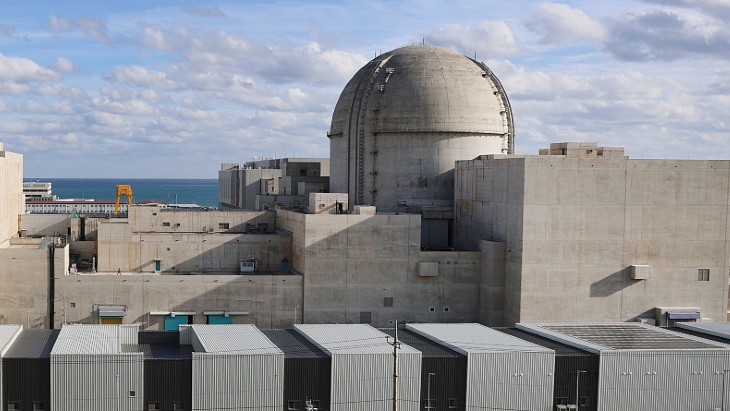In preparation for the installation of a fuel removal machine and a protective cover over unit 3 of the damaged Fukushima Daiichi plant in Japan, workers have carried out a practice run of installing roof modules onto the base of the fuel handling machine.
.jpg) |
| Sections of the cover upon the base of the fuel removal machine (Image: Tepco) |
Plans were announced in November 2012 for a cover to be constructed to encase the unit's damaged reactor building, protecting it from the weather and preventing any release of radioactive particles during decommissioning work.
The section of the reactor building that sheltered the service floor of unit 3 was wrecked by a hydrogen explosion three days after the tsunami of March 2011 - leaving the fuel pond exposed and covered by debris including many twisted steel beams.
The fabrication of the cover has been under way since November 2013 at the Onahama works in Iwaki city. It has been made in sections so that once it is transported to Fukushima Daiichi, the time to assemble it can be shortened and the radiation exposure to the workers on site can be significantly reduced, Tokyo Electric Power Company (Tepco) said.
A separate structure will be built to facilitate the removal by crane of used fuel from the storage pool. This 54-metre-tall structure will include a steel frame, filtered ventilation and an arched section at its top to accommodate the crane. Measuring 57 metres long and 19 metres wide, it will not be fixed to the reactor building itself, but will be supported on the ground on one side, and against the turbine building on the other.
A detailed replica of a portion of the Fukushima Daiichi site has been created at Onahama to enable workers to train in highly realistic conditions, Tepco said. Training began in May and will continue through June.
On 10 June, workers at Onahama assembled sections of the cover on the base of the specially-made fuel removal machine and slid them into place to make a roof, Tepco announced.
Although the largest pieces of rubble have already been removed, once installed the remotely-operated fuel removal machine will be used to clear the remaining rubble and the 566 fuel assemblies from the unit's storage pool. The removal of debris and fuel using the system is scheduled to begin in fiscal 2017.
The fuel removed from unit 3 will be packaged for transport the short distance to the site's communal fuel storage pool, although it will need to be inspected and flushed clean of dust and debris.
Researched and written
by World Nuclear News




_72306.jpg)


_49562.jpg)





